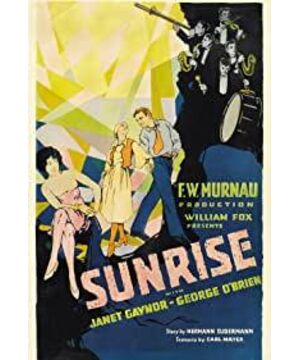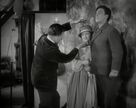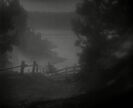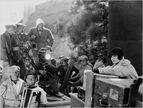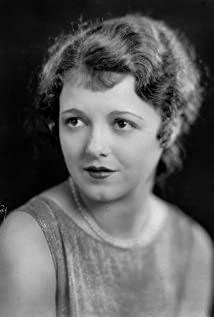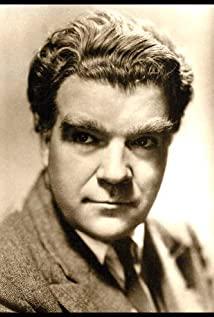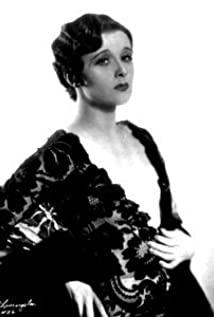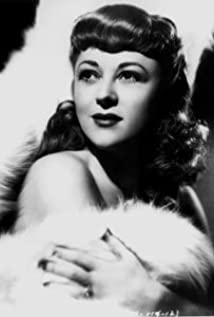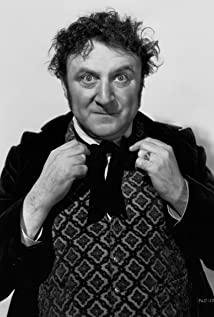I remember that after watching Griffith's "Party Together Facing Differences", I was amazed by the effect of the parallel editing of the film. From then on, I realized that the early filmmakers' exploration of "storytelling with images" was far deeper than I thought. And this "Sunrise" showed me the basic rules of film language in the next 100 years. And no matter how ingeniously improved it was made by later generations, it does not have the essence of the film's language. In the silent film era, because there is no sound. The actors cannot convey the film information by speaking. In order to maintain overall continuity, subtitles can also be saved. This also makes it necessary for the director to express as much information as possible through the language of the lens. Even nowadays, the same information is expressed in images at a much higher level than in lines. And this "Sunrise" is a good example of the silent film era relying on the lens to speak. 1. The long-lens and perspective film were released in 1927. Back then, there was no Steadicam. It was very difficult for photographers to achieve handheld follow-up shots, but in this film, we saw the embryonic form of long-lens shooting.
The first frame of the shot, an old couple is in the foreground in the lower right corner of the frame. The outer wall of the fence and the road parallel to it form a linear perspective and provide a deep depth of field. At this time, the city girl walked towards the camera from the door in the deep view, and when she entered the center of the frame, the camera panned to the left to follow the character. When the character is about to move away from the camera, the camera starts to follow the character to move outside the actor's house, and the whole shot ends. Although one shot will take a long time in the early days of the movie, it seems that long shots are not a new technique. But the long shots we are talking about here are not just shot time, but a series of processes with shot movement and scene scheduling. In the still pictures of the first half, the director uses the principle of perspective and the scheduling of actors to achieve the movement relationship between the foreground and the background. The follow-up in the second half maintains the continuity of the shot and the audience's sense of substitution. This is the audience's recollection: Where did this woman go out sneaking out of the house in the middle of the night? If three shots are used here to edit together, although the same information can be expressed, the continuity and sense of substitution are broken. 2. Split screen Generally speaking, the use of multi-frame images can bring an omniscient perspective to the audience and show the actions of several characters at the same time. But here, the kaleidoscope-style split screen of the director's movement shows the prosperity of the city, and the kaleidoscope-style screen also corresponds to the image of the city's feasting and feasting.
3. Overprinting effect Overprinting effect can express the dreams, imagination or memories of characters.
The actor is fighting a psychological battle over whether to kill his virtuous wife. At this time, the image of the city girl is cleverly attached to the actor's body through overprinting. Through this effect image, the male protagonist failed to withstand the temptation of the junior's desire when he struggled in his heart, and finally chose to kill his wife.
Here it shows the love of the couple, and even the angels send blessings to them. 4. Close-up shots can effectively highlight important information in the picture and enhance the impact of the picture. The effect is remarkable in the performance of horror effects.
These three shots zoomed in on the protagonist's almost perverted motives for killing through close-ups of reeds, hands and a knife. Even a very ordinary reed uses close-up shots to give the audience a sense of horror, because it symbolizes murder. At the same time, it reminds the audience that this important prop will play an important role in the future.
The lens keeps zooming in, until the final close-up shot, the audience can clearly see the tears of the old woman. Through the magnification of this series of lenses, the emotions of the audience are also magnified, and it also shows the process of the hero gradually learning that his wife is not dead. If only the last close-up shots are used, the emotional expression will appear abrupt and incoherent. 5. Viewpoint lens
What's more clever here is the subjective shot of the little three girls. The director showed the villagers' rescue process through Piao San's peeping on the one hand, and on the other hand, he brought the audience into Piao San's perspective, and learned the news of the death of the heroine through her. This greatly increased the audience's hatred of Xiaosan and regret for the couple's failure to reunite. 6. Blank screen creates suspense
In the final rescue scene, the whole village rowed a boat to find the heroine. At this time, the camera cuts to the heroine floating in the water, unconscious, and reeds are constantly scattered, reminding the audience that time is running out. The characters draw out the screen, and the audience sweats for the heroine. Everyone is expecting the husband to find a wife. At this time, the husband found the bunch of reeds, matched with his desperate facial close-up. This left the audience with no time to think, and instinctively followed the actor to believe that his wife was dead. Of course, we all know that the wife is not dead, and the director deceived the audience through blank spaces and editing, creating ups and downs in the plot. 7. The background sound in the silent film. What's interesting is that although the film is a silent film, some background sounds are still used throughout the film. For example, the bells of the church have been running through. At the beginning of the film the night when the protagonist decided to kill his wife, he lay on the bed and looked at his wife. The church under the mist shrouded in dissolving, and the bell rang for the first time. The bells here symbolize sin and also explain the past of the night.
Later, on the boat, the husband tried to strangle his wife. The wife was frightened and begged for mercy. At this time, the husband could not resist the conscience of condemnation. The husband covered his eyes with his hands and the bell rang for the second time. It represents God's warning to her husband, hoping to arouse his inner conscience. The husband quickly moved across to the other side, the bell kept ringing, and every sound struck deep in the husband's conscience, making him feel ashamed and regret it.
The third time the church bell drew the couple to the church, where a wedding was being held. At this time, the priest told the groom to protect the bride from any harm. At this time, the husband shed tears of repentance. The bell here represents God's education to him, guiding him to become a qualified husband.
The two walked out of the church under the bell, representing the rebirth of their marriage.
At the end of the film, the sun that has always been present finally rises and shines on the happy couple. It indicates that love will eventually overcome evil, and the sunshine of justice will eventually shine on the land!
View more about Sunrise reviews


